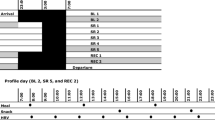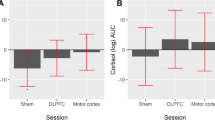Abstract
Restricted Environmental Stimulation Therapy (REST), which involves placing an individual into an environment of severely reduced stimulation for brief periods, has been subjectively reported to produce deep relaxation. The present study determines the effects of REST-assisted relaxation on plasma cortisol, ACTH, and luteinizing hormone (LH). These parameters were also measured in a group exposed to a similar relaxation paradigm, but without REST (non-REST). Each subject experienced two baseline sessions (1 and 2), four REST (or non-REST) relaxation sessions (3, 4, 5, 6), and two follow-up sessions (7 and 8). Pre- and postsession plasma hormone levels were measured in sessions 1, 2, 5, and 8. Both REST and non-REST subjects reported that the experience was relaxing. During the treatment period (session 5) pre- to postsession changes in cortisol and ACTH, but not in LH, were significantly greater for the REST group than for the non-REST group. Plasma cortisol level also decreased across sessions in the REST group, with levels in sessions 5 and 8 significantly lower than the baseline (sessions 1 and 2). Non-Rest subjects showed no change in plasma cortisol across sessions. No significant change in plasma ACTH or LH occurred across sessions in the REST or non-REST groups, although ACTH showed a decreasing trend. These data demonstrate that repeated brief REST-assisted relaxation produces a relaxation state associated with specific decreases in pituitary-adrenal axis activity.
Similar content being viewed by others
References
Ader, R., & Cohen, N. Behaviorally conditioned immunosuppression.Psychosomatic Medicine 1975,37 333–340.
Besser, G. M., Orth, D. N., Nicholson, W. E., Byyny, R. L., Abe, K., & Woodham, J. P. Dissociation of the disappearance of bioactive and radioimmunoactive ACTH from plasma in man.Journal of Clinical Endocrinology and Metabolism 1971,32 595–603.
Boyar, R., Perlow, M., Hellman, L., Kapen, S., & Weitzman, E. Twenty-four hour pattern of luteinizing hormone secretion in normal men with sleep stage recording.Journal of Clinical Endocrinology and Metabolism 1972,35 72–81.
Cohen, S. I., Silverman, A. J., & Shmavonia, B. M. Psychophysiological studies in altered sensory environments.Journal of Psychosomatic Research 1962,6 259–281.
Davidson, D. M., Winchester, M. A., Taylor, C. B., Alderman, E. A., & Ingels, N. B. Effects of relaxation therapy on cardiac performance and sympathetic activity in patients with organic heart disease.Psychosomatic Medicine 1979,41 303–309.
Filicori, M., Bolelli, G., Franceschetti, F., & Lafisca, S. The ultraradian pulsatile release of gonadotropins in normal female subjects.ACTA European Ferility 1979,10(1), 29–33.
Fine, T. H., & Turner, J. W., Jr. The effect of brief restricted environmental stimulation therapy in the treatment of essential hypertension.Behavioral Therapist 1982, 520: 567–570.
Gallagher, T. F., Yoshida, K., Roffwarg, H. Fukushima, D., Weitzman, E., & Hellman, L. ACTH and cortisol secretory patterns in man.Journal of Clinical Endocrinology and Metabolism 1973,36 1058–1068.
Hanna, T. D., Burns, N. M., & Tiller, P. R. Behavioral and physiological response to varying periods of sensory deprivation. Air Crew Equipment Laboratory, U.S. Naval Air Material Center, Philadelphia,Bureau of Medicine Subtask, 1963, MR005, 13-066.6.
Jevning, R., Wilson, A., & Davidson, J. M. Adrenocortical activity during meditation.Hormones and Behavior 1978,10 54–60.
Jevning, R., Wilson, A., Vanderlaan, E., & Levine, S. Plasma prolactin and cortisol during transcendental meditation.Proceedings of the Endocrine Society, 1975, p. 257.
Lilly, J. C.The deep self. New York: Simon & Schuster, 1977.
McGrady, A. V., Tan, S. V., Crane, R. Fine, T., & Yonker, R. Biochemical correlates of biofeedback in essential hypertension.Biofeedback and Self-Regulation 1979,4 258.
McGrady, A. V., Yonker, R., Tan, S. Y., Fine, T. H., & Woerner, M. The effect of biofeedback-assisted relaxation training on blood pressure and selected biochemical parameters in patients with essential hypertension.Biofeedback and Self-Regulation 1981,6 343–353.
Mendelson, J., Kubzansky, P. E., Liederman, P. H., Wexler, D., Dutoit, D., & Solomon, P. Cathecholamine excretion and behavior during sensory deprivation.Archives of General Psychiatry 1960,116 883–888.
Michaels, R. R., Huber, M. J., & McCann, D. S. Evaluation of transcendental meditation as a method of reducing stress.Science 1976,192 1242–1244.
Michaels, R. R., Parra, J., McCann, D. S., & Vander, A. J. Renin, cortisol and aldosterone during transcendental meditation.Psychosomatic Medicine 1979,41 50–54.
Miyabo, S., Hisada, T., Asato, T., Mizushima, N., & Ueno, K. Growth hormone and cortisol responses to psychological stress: Comparison of normal and neurotic subjects.Journal of Clinical Endocrinology and Metabolism 1976,42 1116–1120.
Patel, C. Twelve-month follow-up of yoga and biofeedback in the management of hypertension.Lancet 1975,1 62–65.
Patel, C. H., & North, W. R. S. Randomized controlled trial of yoga and biofeedback in management of hypertension.Lancet 1975,2 93–95.
Schalch, D. S., Parlow, A. F., Boon, R. C., & Reichlin, S. J. Measurement of human luteinizing hormone in plasma by radioimmunoassay.Journal of Clinical Investigators 1968,47 665–678.
Selye, H.Stress in health and disease. Boston: Butterworths, 1976, 1256 p.
Suedfeld, P. InRestricted environmental stimulation: Research and clinical applications. New York: Wiley, 1980.
Zubeck, J. P. In J. Zubeck (Ed.),Sensory deprivation: Fifteen years of research. Appleton-Century-Crofts, 1969, Pp. 254–289.
Zuckerman, M. Persky, H., Hopkins, T. R., Murtaugh, T., Basu, G. K., & Schilling, M. Comparison of stress effects of perceptual and social isolation.Archives of General Psychiatry 1966,14 356–365.
Author information
Authors and Affiliations
Rights and permissions
About this article
Cite this article
Turner, J.W., Fine, T.H. Effects of relaxation associated with brief restricted environmental stimulation therapy (REST) on plasma cortisol, ACTH, and LH. Biofeedback and Self-Regulation 8, 115–126 (1983). https://doi.org/10.1007/BF01000542
Issue Date:
DOI: https://doi.org/10.1007/BF01000542




